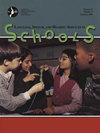Functional Language Proficiency in Bilingual Children: A Conceptual Framework, Culturally Responsive Practice, and Measurement Approach.
IF 2.9
3区 医学
Q1 AUDIOLOGY & SPEECH-LANGUAGE PATHOLOGY
Language Speech and Hearing Services in Schools
Pub Date : 2025-05-19
DOI:10.1044/2025_lshss-24-00166
引用次数: 0
Abstract
PURPOSE Functional language proficiency is presented as a conceptual framework that builds upon cultural-linguistic assets in bilingually developing children and bridges the theory of natural translation, translanguaging, and language brokering practices. A novel task was developed based on this framework for quantifying Spanish-English bilingual children's functional language proficiency. The development, feasibility, face, and convergent validity of the Functional Language Proficiency (FLiP) task are detailed as part of this work, as well as its application and utility as a culturally responsive practice. METHOD A conceptual framework and novel task were developed based on bilingual communication practices. This article details the conceptual framework and development process of the task, including considerations for cultural relevance, memory demands, linguistic complexity, and scoring procedures. The FLiP was administered to 90 Spanish-English learning Latino children in first, second, and third grade (30 per grade). RESULTS All 90 first-, second-, and third-grade children completed the task, generating an expectedly wide range of proficiency profiles across both languages. Importantly, 86% of the children reported that they had engaged in these language practices in their daily lives. There was strong interrater reliability (94%), and scores on the FLiP were positively correlated with measures of language sample analyses in both languages. CONCLUSIONS The results of this study showed that the FLiP was an age-appropriate, asset-based, and culturally relevant task for measuring functional language proficiency in most Spanish-English school-age bilinguals. The role of functional proficiency is discussed, along with future research directions including validation, item analysis, and task refinement. SUPPLEMENTAL MATERIAL https://doi.org/10.23641/asha.28946261.双语儿童的功能语言能力:概念框架、文化响应实践和测量方法。
目的功能性语言能力是建立在双语发展儿童的文化-语言资产基础上的一个概念框架,并将自然翻译理论、译语理论和语言中介实践联系起来。本研究在此基础上开发了一种量化西英双语儿童功能语言能力的新任务。本文详细介绍了功能性语言能力(FLiP)任务的发展、可行性、面貌和收敛有效性,以及它作为一种文化响应实践的应用和效用。方法在双语交际实践的基础上,提出一个概念框架和新任务。本文详细介绍了该任务的概念框架和开发过程,包括对文化相关性、记忆需求、语言复杂性和评分程序的考虑。对90名一年级、二年级和三年级的西班牙语-英语学习拉丁裔儿童(每个年级30名)进行FLiP测试。结果所有90名一年级、二年级和三年级的孩子都完成了任务,产生了预期的两种语言的广泛熟练程度概况。重要的是,86%的孩子报告说他们在日常生活中进行过这些语言练习。有很强的互译信度(94%),并且FLiP的分数与两种语言的语言样本分析测量呈正相关。结论:本研究结果表明,FLiP是一项与年龄相适应、以资产为基础、与文化相关的任务,可用于衡量大多数学龄西班牙语-英语双语者的功能性语言能力。讨论了功能熟练度的作用,以及未来的研究方向,包括验证、项目分析和任务细化。补充MATERIALhttps: / / doi.org/10.23641/asha.28946261。
本文章由计算机程序翻译,如有差异,请以英文原文为准。
求助全文
约1分钟内获得全文
求助全文
来源期刊

Language Speech and Hearing Services in Schools
Social Sciences-Linguistics and Language
CiteScore
4.40
自引率
12.50%
发文量
165
期刊介绍:
Mission: LSHSS publishes peer-reviewed research and other scholarly articles pertaining to the practice of audiology and speech-language pathology in the schools, focusing on children and adolescents. The journal is an international outlet for clinical research and is designed to promote development and analysis of approaches concerning the delivery of services to the school-aged population. LSHSS seeks to advance evidence-based practice by disseminating the results of new studies as well as providing a forum for critical reviews and meta-analyses of previously published work.
Scope: The broad field of audiology and speech-language pathology as practiced in schools, including aural rehabilitation; augmentative and alternative communication; childhood apraxia of speech; classroom acoustics; cognitive impairment; craniofacial disorders; fluency disorders; hearing-assistive technology; language disorders; literacy disorders including reading, writing, and spelling; motor speech disorders; speech sound disorders; swallowing, dysphagia, and feeding disorders; voice disorders.
 求助内容:
求助内容: 应助结果提醒方式:
应助结果提醒方式:


